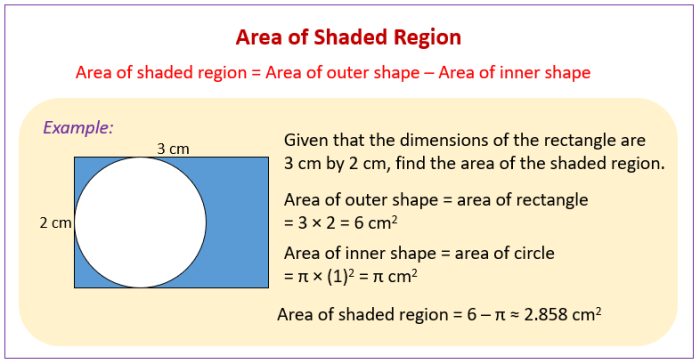Embark on a mathematical journey with our comprehensive “Area of Composite Figures and Shaded Regions Worksheet,” meticulously crafted to guide you through the intricacies of geometric calculations. Delve into the realm of composite figures and shaded regions, unlocking the secrets to determining their areas with precision and confidence.
This worksheet provides a thorough exploration of the fundamental concepts, step-by-step methodologies, and practical applications of calculating areas in geometry. Prepare to enhance your understanding and problem-solving skills as we delve into the fascinating world of shapes and their measurements.
Area of Composite Figures and Shaded Regions: Area Of Composite Figures And Shaded Regions Worksheet

Composite figures are shapes formed by combining two or more simpler shapes. Shaded regions are areas within a composite figure that are shaded or filled in. Understanding the areas of composite figures and shaded regions is crucial in various fields, including architecture, engineering, and design.
Methods for Calculating Area
To calculate the area of a composite figure, we can decompose it into simpler shapes. This involves dividing the composite figure into smaller shapes, such as rectangles, triangles, and circles, whose areas can be easily calculated. The total area of the composite figure is then the sum of the areas of the smaller shapes.
The formulas for calculating the areas of different shapes are:
- Rectangle: Area = length x width
- Triangle: Area = (base x height) / 2
- Circle: Area = πr², where r is the radius
Practice Problems, Area of composite figures and shaded regions worksheet
| Problem | Difficulty | Solution |
|---|---|---|
| Calculate the area of a composite figure formed by a rectangle with length 10 cm and width 5 cm, and a triangle with base 6 cm and height 8 cm. | Easy | Area of rectangle = 10 cm x 5 cm = 50 cm²Area of triangle = (6 cm x 8 cm) / 2 = 24 cm²Total area = 50 cm² + 24 cm² = 74 cm² |
| Find the area of the shaded region within a circle with radius 10 cm and a square with side length 8 cm inscribed in the circle. | Medium | Area of circle = π x 10² cm² = 100π cm²Area of square = 8 cm x 8 cm = 64 cm²Area of shaded region = 100π cm²
|
Applications
Calculating the areas of composite figures and shaded regions has practical applications in various fields:
- Architecture:Determining the area of a building’s floor plan or the surface area of a roof.
- Engineering:Calculating the area of a cross-section of a bridge or the surface area of a solar panel.
- Design:Determining the area of a painting, a poster, or a piece of fabric.
FAQ Guide
What are composite figures?
Composite figures are geometric shapes composed of two or more simpler shapes combined.
How do I calculate the area of a shaded region?
To calculate the area of a shaded region, subtract the area of the unwanted portion from the area of the larger shape.
What is the formula for calculating the area of a triangle?
The formula for calculating the area of a triangle is A = (1/2) – base – height.


